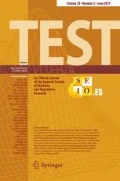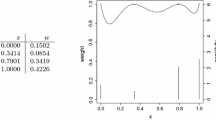Abstract
Bayesian design requires determining the value of controllable variables in an experiment to maximise the information that will be obtained for subsequently collected data, with the majority of research in this field being focused on experiments that yield a univariate response. In this paper, a robust and computationally efficient Bayesian design approach is proposed to derive designs for experiments which yield bivariate discrete and mixed responses. To construct the joint distribution of responses, Copula models are considered, and a sequential Monte Carlo algorithm is adopted to reduce the computational effort required in deriving sequential designs. The total entropy utility function is considered to derive designs for the dual experimental goals of parameter estimation and model discrimination for Copula models. The results show that designs constructed within our framework are able to precisely estimate model parameters and that it is possible to discriminate between different competing Copula models. However, for experiments which yield binary and continuous data, it appears as though discriminating between Copula models can require a large number of data points, which may limit the general applicability of our methods and/or the range of experimental objectives that can be considered in experiments that yield multiple responses.










Similar content being viewed by others
References
Atkinson AC (2005) Robust optimum designs for transformation of the responses in a multivariate chemical kinetic model. Technometrics 47(4):478–487
Borth DM (1975) A total entropy criterion for the dual problem of model discrimination and parameter estimation. J R Stat Soc Ser B (Methodol) 37(1):77–87
Brechmann EC, Schepsmeier U et al (2013) Modeling dependence with C-and D-vine Copulas: the R-package CDVine. J Stat Softw 52(3):1–27
Carlin BP, Kadane JB, Gelfand AE (1998) Approaches for optimal sequential decision analysis in clinical trials. Biometrics 54(3):964–975
Chaloner K, Verdinelli I (1995) Bayesian experimental design: a review. Stat Sci 10(3):273–304
Clyde M, Chaloner K (1996) The equivalence of constrained and weighted designs in multiple objective design problems. J Am Stat Assoc 91(435):1236–1244
Craiu RV, Rosenthal JS (2014) Bayesian computation via Markov chain Monte Carlo. Ann Rev Stat Appl 1:179–201
Del Moral P, Doucet A, Jasra A (2006) Sequential Monte Carlo samplers. J R Stat Soc Ser B (Stat Methodol) 68(3):411–436
Deldossi L, Osmetti SA, Tommasi C (2018) Optimal design to discriminate between rival copula models for a bivariate binary response. TEST
Denman NG, McGree JM, Eccleston JA, Duffull SB (2011) Design of experiments for bivariate binary responses modelled by Copula functions. Comput Stat Data Anal 55(4):1509–1520
Drovandi CC, McGree JM, Pettitt AN (2013) Sequential Monte Carlo for Bayesian sequentially designed experiments for discrete data. Comput Stat Data Anal 57(1):320–335
Drovandi CC, McGree JM, Pettitt AN (2014) A sequential Monte Carlo algorithm to incorporate model uncertainty in Bayesian sequential design. J Comput Graph Stat 23(1):3–24
Durante F, Sempi C (2010) Copula theory: an introduction. In: Copula theory and its applications. Springer, New York, pp 3–31
Genest C, MacKay J (1986) The joy of Copulas: bivariate distributions with uniform marginals. Am Stat 40(4):280–283
Gueorguieva I, Aarons L, Ogungbenro K, Jorga KM, Rodgers T, Rowland M (2006) Optimal design for multivariate response pharmacokinetic models. J Pharmacokinet Pharmacodyn 33(2):97
Hill WJ, Hunter WG, Wichern DW (1968) A joint design criterion for the dual problem of model discrimination and parameter estimation. Technometrics 10(1):145–160
Kullback S, Leibler RA (1951) On information and sufficiency. Ann Math Stat 22(1):79–86
Liu JS (2008) Monte Carlo strategies in scientific computing. Springer, New York (Incorporated)
Lopez-Fidalgo J, Tommasi C, Trandafir PC (2007) An optimal experimental design criterion for discriminating between non-normal models. J R Stat Soc Ser B (Stat Methodol) 69(2):231–242
McGree JM (2017) Developments of the total entropy utility function for the dual purpose of model discrimination and parameter estimation in Bayesian design. Comput Stat Data Anal 113:207–225
McGree JM, Drovandi CC, Thompson M, Eccleston J, Duffull S, Mengersen K, Pettitt AN, Goggin T (2012) Adaptive Bayesian compound designs for dose finding studies. J Stat Plan Inference 142(6):1480–1492
McGree JM, Drovandi CC, White G, Pettitt AN (2016) A pseudo-marginal sequential Monte Carlo algorithm for random effects models in Bayesian sequential design. Stat Comput 26(5):1121–1136
McGree JM, Eccleston JA (2008) Probability-based optimal design. Aust N Z J Stat 50(1):13–28
Montgomery DC (2006) Design and analysis of experiments. Wiley, New York
Nelsen RB (2006) An introduction to Copulas, 2nd edn. Springer Series in Statistics, Springer-Verlag, New York
Overstall AM, McGree JM, Drovandi CC (2018) An approach for finding fully Bayesian optimal designs using normal-based approximations to loss functions. Stat Comput 28(2):343–358
Overstall AM, Woods DC (2017) Bayesian design of experiments using approximate coordinate exchange. Technometrics 59(4):458–470
Overstall AM, Woods DC, Adamou M (2018) acebayes: an R package for Bayesian optimal design of experiments via approximate coordinate exchange. arXiv:1705.08096
Panagiotelis A, Czado C, Joe H, Stöber J (2017) Model selection for discrete regular vine Copulas. Comput Stat Data Anal 106:138–152
Perrone E, Müller WG (2016) Optimal designs for Copula models. Statistics 50(4):917–929
Perrone E, Rappold A, Müller WG (2016) \({D}_s\)-optimality in Copula models. Stat Methods Appl 1–16
Schoelzel C, Friederichs P (2008) Multivariate non-normally distributed random variables in climate research-introduction to the Copula approach. Nonlinear Process Geophys 15(5):761–772
Sklar A (1959) Fonctions de répartition à n dimensions et leurs marges. Publications de l’Institut de Statistique de L’Université de Paris 8:229–231
Song PX-K, Li M, Yuan Y (2009) Joint regression analysis of correlated data using gaussian Copulas. Biometrics 65(1):60–68
Tao A (2010) A dose-finding method in joint modeling of efficacy and safety endpoints in phase II studies: an extension of the MCP-Mod method, PhD thesis, University of Medicine and Dentistry of New Jersey
Tao Y, Liu J, Li Z, Lin J, Lu T, Yan F (2013) Dose-finding based on bivariate efficacy-toxicity outcome using archimedean Copula. PLoS ONE 8(11):1–6
Tierney L (1994) Markov chains for exploring posterior distributions. Ann Stat 22(4):1701–1728
Waterhouse T, Woods D, Eccleston J, Lewis S (2008) Design selection criteria for discrimination/estimation for nested models and a binomial response. J Stat Plan Inference 138(1):132–144
Weir CJ, Spiegelhalter DJ, Grieve AP (2007) Flexible design and efficient implementation of adaptive dose-finding studies. J Biopharm Stat 17(6):1033–1050
Acknowledgements
SGJS was supported by QUTPRA scholarship from the Queensland University of Technology. CCD was supported by an Australian Research Council’s Discovery Early Career Researcher Award funding scheme (DE160100741). Computational resources and services used in this work were provided by the HPC and Research Support Group, Queensland University of Technology, Brisbane, Australia.
Author information
Authors and Affiliations
Corresponding author
Additional information
Publisher's Note
Springer Nature remains neutral with regard to jurisdictional claims in published maps and institutional affiliations.
Electronic supplementary material
Below is the link to the electronic supplementary material.
Rights and permissions
About this article
Cite this article
Senarathne, S.G.J., Drovandi, C.C. & McGree, J.M. Bayesian sequential design for Copula models. TEST 29, 454–478 (2020). https://doi.org/10.1007/s11749-019-00661-7
Received:
Accepted:
Published:
Issue Date:
DOI: https://doi.org/10.1007/s11749-019-00661-7
Keywords
- Model discrimination
- Parameter estimation
- Sequential design
- Sequential Monte Carlo
- Total entropy
- Utility function




